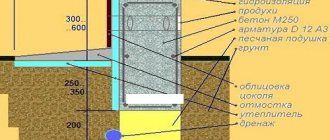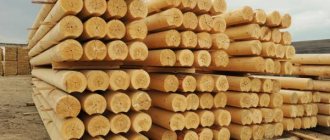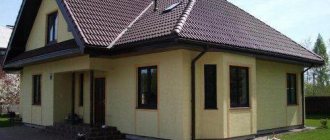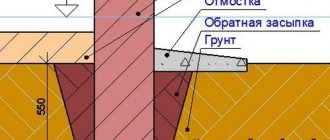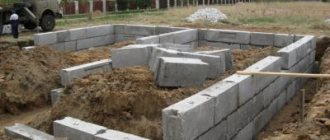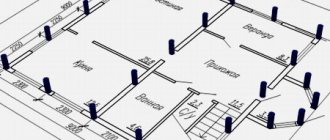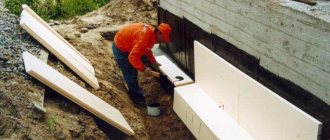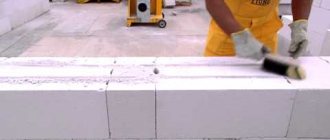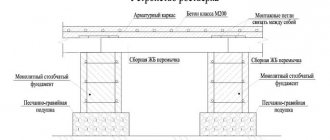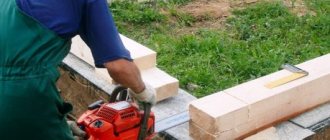House without concrete foundation
The modern way of building houses involves the use of a variety of building parts, which have a direct impact on the quality of the building. One of these construction parts is considered to be the foundation for the building. However, concrete consistency was not used before centuries ago. Why then, today most people ask questions: is it possible to construct a house without a foundation or not?
The first thing you need to understand is why a foundation for a building is required. The main requirement of a concrete foundation is to withstand the enormous load of a heavy house. It ends up on the ground due to the bulky elements of the building's construction. This means that almost any flat plane will be a suitable option. This role can be performed by reliable waterproofing. The second important purpose of the foundation is resistance to deformation under the influence of soil heaving. This function can be well performed by an elastic layer of any kind. It will reliably dampen any soil vibrations.
The third function of the foundation is ventilation of the lower level of the building. Otherwise, you can safely discard it by resorting to the help of specialized solutions. By treating the first crowns of a wooden structure, this ensures reliable protection of the wooden material from rotting. In this regard, you can safely build a house without a foundation by replacing the usual concrete foundation with a flat and solid platform. In functionality, such a house will compete with classical types of construction.
A small garden house without a foundation is subject to registration or not
the risk of such claims against ancillary buildings is low. 02/21/2017 Answered by: Lawyer-consultant In order to understand whether it is necessary to register a garden house on tubular posts (stilts), you need to understand what general rules and specific criteria exist for classifying a particular property as an object, registration in the cadastral register accounting of which is mandatory.
Is it necessary to register a country house without a foundation?
In one case, moving such objects will cause them disproportionate damage, but in another - not (for example, depending on the size, design, material). From practice it follows that real estate includes not only objects with a foundation, but also buildings such as wooden garden houses on stilts, which, from the point of view of the Town Planning Code of the Russian Federation, are not capital construction projects.
This is interesting: Kak according to the count of 109 food products in 2020
The situation is similar in the case of registration of objects in rural areas. On a summer cottage in a village, you can build residential buildings, garages, sheds, barns, bathhouses, greenhouses and other buildings. The owner may be provided with a plot for individual housing construction, agricultural land or area for gardening.
An alternative to the foundation of a house
In order to construct a house without a foundation, it is necessary to replace the concrete foundation with an alternative one. For this you can use ordinary car tires. At the time of mounting the tires, timber is laid on some of them for strapping. This type of material is the most affordable, and such a base serves for a long time.
Having laid the car tires on the site around the perimeter of the future house, it is necessary to partially fill them with sand of any fraction. After which the filled sand is moistened and compacted, then the procedure is repeated. The stages are carried out until half the tire is filled.
Then you need to pour medium-sized crushed stone. The result will be identical in characteristics to an ordinary concrete base. The base, constructed from car tires, has the following advantages:
- Good shock-absorbing characteristics, due to this there is good protection against heaving in the ground
- The ecology of the structure is preserved
- A building with a typical foundation has good stability. Based on the large number of positive reviews from people who once used this type of foundation, we can conclude that distortions of load-bearing walls do not occur.
- The material is accessible to any buyer, unlike a concrete structure.
- It is possible to construct a foundation of this type without extensive experience in the construction industry.
Foundation consisting of boulders
Installation of such a foundation is considered cheap only in construction in mountainous areas where rock elements, that is, boulders, can be found. Stages of constructing a rock foundation:
- The first step is to carry out marking work on the surface of the soil located at the construction site
- Boulders should be sorted by size, after which they should be stacked close to the construction site. Large stones should be placed in a separate pile, as they will be useful in the final arrangement.
- Installation work should begin with preparatory work, that is, with digging ditches. The largest boulders will be deposited at its bottom. Natural stones must be fastened together, otherwise the foundation will not work. For this purpose, a cement mortar or clay with medium sand is most often used.
- The frame beams of the structure are installed on top of large stones.
Upon completion of the installation work, a full-fledged base is obtained that is in no way inferior to the traditional version. Its characteristics exceed those of a concrete foundation in terms of strength and durability. During the period of soil heaving, the structure of the house is not subject to deformation, since the large weight of the stones dampens any manipulation.
Which brick to choose?
For the construction of the foundation, you should choose only solid burnt red ceramic bricks. It is characterized by high strength and low moisture permeability. Provided proper waterproofing is installed, a foundation made of such bricks can be used for many decades without losing its original characteristics.
The most important parameter of solid ceramic bricks chosen for the construction of a foundation is frost resistance (F). It shows how many freezing and thawing cycles the material can withstand. For example, if the frost resistance index is F35, then the manufacturer guarantees that a brick of this brand is guaranteed to last 35 years without visible signs of destruction of the foundation. Don't forget about this indicator when purchasing material. The higher the parameter F, the higher the service life of the foundation.
The bricks that are supposed to be used to build the foundation are selected especially carefully. For this purpose, only burnt bricks that do not have cracks are suitable; they produce a ringing sound when struck. Preference is given to red solid brick of grades M-150, M-200 and higher. Material grades M-100 and M-125 are not recommended.
Once again, we draw your attention to the fact that the use of silicate or lightweight hollow bricks for a brick columnar foundation is not allowed.
To compare the characteristics of silicate and ceramic bricks, we suggest you read the article “Silicate vs Ceramic”.
Advantages of a brick foundation
- Possibility of self-construction of the foundation (Absence of heavy elements and large structures. No need to involve heavy construction equipment).
- Ease of restoration of brickwork by replacing its individual fragments in case of partial destruction of the base.
- General advantages of columnar foundations.
Concrete blocks instead of a base
Blocks made from concrete are used as the basis for a building in several ways:
- Concrete blocks are installed in places of load-bearing walls, covering the entire length with indentations into the span. They are also installed around the perimeter of the building, that is, as with the usual laying of the base. The resulting joints must be laid using a solution made from a cement consistency. Before installation begins, trenches or holes should be dug. After this, a layer of sand cushion and a small amount of crushed stone is poured into them. Having finished laying the layer, it is necessary to compact it thoroughly. Roofing material must be laid on top. Only after this are concrete blocks installed.
- The hollow concrete block is laid in two rows. With their help, the supports are folded into a pair of concrete blocks. Installation is carried out at the corners of the building and along the perimeter of load-bearing walls. In another method, concrete masonry is installed with a height of 2 rows. One layer of roofing material is laid on top.
The first installation option is more expensive than the second because installation will require the help of a crane. The second method is considered more accessible and easier to install. Both options require a waterproofing process, for example: you can treat with bitumen and hide the flaws with finishing.
Digging a ditch for the foundation
This is what a finished foundation pit for an adobe house looks like
After installing the pegs and checking the diagonals, you can begin digging a ditch for pouring the foundation. We have already decided on the width, but the depth will be from 70 cm to 1 m. It is very important that the bottom of the ditch is horizontal, otherwise all the “milk” of the solution will then collect unevenly somewhere in the corners. The dug trench must be lined with roofing felt or some other material so that the liquid is retained in the solution. The roofing material is covered with a layer of sand in a 10-12 cm ball, which is then carefully compacted with a tamper, which is a log with a handle nailed to it at the top.
The level of the bottom of a trench can be measured in various ways. A water level is often used for these purposes, which works on the principle of communicating vessels, where, as is known, water is installed at the same level. Structurally, it is made of two glass tubes connected to each other by a PVC tube. The tubes are filled with water and determine horizontality with great accuracy. To use this level, two people are enough to place straws of water in the places of interest.
Screw base
Nowadays, the majority of people want to make a country house on their own, and choose wood for this. The fact is that this natural material used in construction is environmentally friendly. It is warm in winter, but not hot in summer. The cost of such construction is quite high, and you should not forget about the foundation on which the wooden house will be built. The cost, for example: a strip foundation is high, and there is a lot of earthwork. There are many disadvantages to the standard method of building a foundation, especially in winter. After laying the concrete foundation, it is necessary to wait time for shrinkage. Otherwise, the structure of a wooden structure installed on concrete will be subject to deformation.
Therefore, one of the simple and affordable base options will be a screw design. By using screw piles, construction time and the cost of the entire construction are reduced. This type of foundation has many advantages.
- Durability of the structure as a whole
- Structural strength
- Cheap installation
- Time to work is reduced
- Good ventilation, thanks to which there is no need to additionally treat the lower rims with chemicals
- Does not negatively affect the environment
- This base is easy to install
- Does not require a perfectly flat site for building a house.
Screw-type bases are the newest technology available today. It is widely used in the construction industry. The supporting screw pile consists of steel and also has blades on the edge. They are necessary for better screwing into the ground, which greatly simplifies the work process. This type of base can be used on soils with any characteristics.
Can I use brick for the foundation?
The use of bricks for the installation of load-bearing structures has certain limitations:
- the maximum load on a brick foundation 0.3 meters wide must be at least 14 tons per square;
- This type of brick is porous and absorbs moisture well. In the spring, during the defrosting process, water destroys the material. When installing a brick foundation, increased attention is paid to waterproofing and protection from soil water;
- on marshy soils, in areas with regular floods and in the presence of underground sources/groundwater close to the surface, installation of a brick foundation is excluded;
- the structure is damaged by tree roots. When laying a brick foundation for a house, it is advisable to uproot all the trees nearby, which means additional labor costs;
- Installation of a brick base is simple, but long. Laying takes more time than pouring concrete or driving piles.
Let's note the advantages:
- shrinkage of a brick foundation occurs faster than other foundations;
- if all necessary protective measures are observed during the installation process, the brick foundation is quite strong and durable (up to half a century of service);
- it is a breathable material;
- laying the foundation does not require heavy equipment (as is the case with concrete), and does not require highly qualified layers;
- relatively light weight;
- environmental cleanliness;
- resistance to mold and rot;
- if there is no near-surface groundwater, laying a brick foundation does not interfere with the construction of a usable basement;
- good maintainability: you can restore individual areas without having to renew the entire masonry and without the risk of the house collapsing.
note
Before deciding to build a brick foundation, you need to collect information about the characteristics of the soil (freezing depth, location of soil water, humidity). This primarily applies to strip foundations.
Foundation on the ground and in a pit
It is worth noting that all load-bearing structures of solid soil range from twelve to fifteen kilograms per square centimeter, which makes it possible for a flat platform to support the structure without laying out a strip foundation and piles. If you already have a layer of waterproofing installed, then the beams can be safely laid on the ground. In order to build a foundation, you first need to dig a pit; its depth should be approximately twenty-five centimeters. After the preparatory work, it is filled with clay, it is advisable to compact it with each layer in order to obtain a hard crust, which is what will withstand the structure. In order to equip the heap, you should install plank formwork over the entire area of the site, its bottom height should reach and be thirty centimeters higher than the pit. Before proceeding directly to the construction process of the structure itself, it is worth laying a layer of waterproofing; the materials for this can be roofing felt. Next, sprinkle the heap with a layer of insulation; in this case, expanded clay can be recommended. Based on the work done, we can say that such a foundation will perfectly support the weight of the building, while the bedding made of expanded clay will act as a shield, which will help protect against heaving. And the layers of roofing felt will work as waterproofing.
Foundation on dense soil
Without a doubt, it is no longer a secret that you can do without laying a foundation. Because the bearing capacity of the soil is twelve kilograms per square centimeter. Based on these numbers, it can be seen that the site will easily support the weight of any frame structure. If at the same time you prepare layers of heat and waterproofing, then the load-bearing beams can be laid on the ground itself.
Stages of formation of the earthen base:
- To begin with, it is worth digging a buried pit of twenty-five centimeters. This should be below the fertile layer. Next, we level the bottom of the pit until it is parallel to the ground surface.
- The next stage will be the installation of plank formwork over the entire area of the building, which will subsequently be considered the basis of the heap. A layer of clay is also placed on the bottom; the size should be about thirty centimeters.
- After some time, the clay hardens and becomes ready to accept and support the weight of the building. Before installing the frame, you should put roofing felt on the wall, and you should also take care of thermal insulation. Therefore, it is worth putting a moisture-resistant material, for example: expanded clay, this is what needs to be poured into the heap box.
The entire weight of the structure rests on the shoulders of the clay surface; in this case, expanded clay protects against heaving and freezing, and also serves as thermal insulation for the building. Since there are cracks in the expanded clay backfill, thanks to them, there is free circulation of air flow in the underground room.
Is it possible to build a house without a foundation?
Are there types of houses that can be built without a foundation?
One of the main requirements for building a house without a foundation is the presence of solid and non-flowing soil. Of course, in some cases this requirement can be neglected, but then the technology for building a house will be much more complicated.
There are a lot of options for building a house without a foundation, here are just some of the existing ones:
The frame is a relatively lightweight structure. A lot of houses have been built around the world using this technology. When building a house using frame technology, it is necessary to provide additional reinforcement of the structure, however, despite this, the work will still cost less than a classic foundation.
A very interesting solution is a foundation made of car tires. In this case, a pit no more than 40 cm deep is dug, a sand cushion about 20 cm thick and a gravel layer about 20 cm thick are laid on the bottom. Tires are laid on the gravel and then covered with sifted wet sand. A structure erected on such an alternative foundation should be small in size, but can last about 50 years.
This type of alternative foundation is used in areas with rocky soil and in mountainous areas. Houses built on boulders are quite stable; a stone foundation has a number of advantages of a conventional, classic foundation. This is a very cheap option for the foundation, since you don’t have to buy the material at all. Large stones are installed in the corners, as well as along the longest walls. Ventilation openings are provided, they are mounted from boards and covered with soil. Houses with such a foundation can last for many years, and the foundation itself does not lose any strength or rot.
There are houses that are built directly on the ground. To do this, it is necessary to make some preparations, namely, remove a small layer of earth, compact and lay a layer of clay on the bottom, it will perform the task of waterproofing. The frame itself is installed directly on the clay.
- brickwork instead of foundation
There is an option to make brickwork instead of a foundation. It is enough to make masonry from high-quality bricks. In fact, columns are erected that perform a load-bearing function.
Therefore, in answer to your question, we can confidently answer “Yes, building a house without a foundation is possible.” But how long such a house will last will depend on the type of soil and the quality of the work performed during the construction of such a house.
In individual housing construction, the foundation, as the independent foundation of a house, became widespread in the 60s of the last century. Previously, wooden houses were placed on the ground, on a leveled area. Rarely did they deepen one or three bottom rows into the ground.
As a rule, larch or oak was used for the lower rows of the log house. The number of lower rows of the log house, which, in fact, were the foundation in our view, depended on the financial capabilities of the owner of the household. If funds allowed, the cutting of the “foundation” could be about 2 m high, which made it possible to use the “ground floor”, for example, as utility rooms for household needs. In Irkutsk, Krasnoyarsk, Tomsk there are still old wooden houses, where the “ground floor” was previously used by the owners for trading (there were shops or taverns there).
Today there is technology for building houses from a variety of frame sandwiches. They can be safely placed on a well-prepared, waterproofed site without a foundation. Of course, there are nuances (freezing zone, embankment technology, wind erosion), but in principle, even in northern latitudes, houses are built without a foundation. An important condition is that the lower part of such a house must have reliable protection against freezing.
Features of the foundation of a thatched house.
A house built using straw technology is much lighter than traditional ones.
The main task of the foundation is load-bearing, so it is possible not to make it as massive as is customary for other construction technologies.
The problem is that the minimum width of a straw wall is 49-56 cm. The straw panel or straw bale must stand on a wooden mauerlat, moisture-proof and securely fixed to the base. It is recommended to make the foundation at least 35-40 cm high to protect the thatched wall from getting wet during heavy rains.
options when building a foundation:
- It is recommended to use basalt or composite fiberglass non-metallic reinforcement. Considering the lightness of straw buildings, there is no need to be afraid, since the technical characteristics of composite reinforcement are almost as good as metal ones, but they are much cheaper and lighter, which allows you to save money.
- Using a large amount of filler in a strip foundation (put, for example, straw
e blocks), or pouring a low monolithic slab that serves as a heated floor and a battery at the same time. You can lay a brick plinth along the perimeter of the concrete slab.
In any case, the strength of such a foundation is much stronger than necessary in engineering calculations for the load of a thatched wall and roof. Calculate the weight of the wall of your house based on the data: the weight of a straw bale from 15 to 25 kg + the weight of the frame or the weight of a straw panel 170 kg + the weight of the roof + snow load in accordance with the maximum precipitation of the region (we calculate the peak load per 1 cm2 of the foundation) + residential load premises (furniture, things, residents, safety margin for special situations). You can take standard calculations for a wooden frame house, make a safety factor multiplied by 2 and the appropriate grade of concrete.
Requirements for the foundation structure for a thatched house.
Foundations for any building structures must meet the following basic requirements:
- have sufficient strength;
- sustainability;
- frost resistance;
- good resistance to the influence of groundwater;
- correspond in durability to the service life of the building;
- be economical.
Typically, the cost of the foundation is about 10% of the cost of building the entire house. Labor intensity is 15%. The weight of the foundation is up to 20% of the total weight of the house. Now we will look at technologies that can greatly reduce these standard indicators.
Types of foundation for a thatched house
TISE technology.
According to TISE technology, a drill creates an expansion in the ground for the foundation - a cushion that creates stability and resistance to the pressure of the house on the concrete pillar. After drilling the hole, reinforcement is tied in and concrete is poured with the top formwork already installed.
Alternatively, you can use a piece of plastic sewer pipe about 25-30 cm in diameter. Also, for a light straw house, you can use composite or basalt reinforcement based on fiberglass, which is cheaper than traditional reinforcement and is almost as good as it in terms of technical characteristics.
Advantages of foundation using TISE technology:
- Minimum investment.
- More manual work means the production time may increase.
- Manual digging of holes for concreting. time and effort depend on size
Houses.
- Minimum tools, saving on mixing concrete yourself.
- Cons: lack of insulation of the foundation itself. Subsequent finishing of the spans under the floor will be necessary.
- Mandatory floor insulation.
Columnar foundation.
Depending on the complexity of the terrain, the depth of soil freezing and the load on the foundation, point support structures and piles are calculated and installed. They can be made from various materials. Installation methods are selected during design.
Columnar foundation made of metal pipes
The foundation can be made of various pipes:
- metal;
- asbestos-cement;
- plastic.
A foundation made of pipes is called a columnar foundation.
Metal supports
Metal pillars can be represented by steel piles and casing pipes driven into the ground, which
They are subsequently filled with concrete mixture. Screw piles are most often used. They are hollow pipes with a conical point at the bottom and a spiral guide blade for screwing into the ground. There are holes on the top of the pile for gates. By vertically screwing it in with your own hands or using a mechanism, it is immersed to a given level. It should be especially emphasized that the work of making such a foundation for a house is all-season, the building is raised above the ground, is not subject to spring flooding and is quickly erected with your own hands. Such a pile can be installed manually by three people, with one constantly monitoring the verticality of the immersed rod. Making your own foundation using screw piles is easy and financially profitable. Such a foundation is used for the construction of a wooden house, bathhouse or fence.
A columnar screw foundation cannot be used on slopes and quicksand. Due to the fact that the house is raised above the ground, large investments will be required to insulate the basement.
The next stage will be the installation of a grillage on piles, which can be a concrete strip or a wooden frame. For light structures, a pile structure made of pipes serves as support pillars for fastening above-ground profiles.
When doing the work yourself, you must use metal pipes with a diameter greater than 250 mm. When installing pipes, the sand cushion must be sufficient to support the heavy structure. There should be at least 30 cm left at the edges of it in order to fill this cavity with clean river sand. Only when the pile stands level and stable can reinforcement be installed into it. The length of the metal rod should be at least 20 cm longer than the whip itself, since it will go deeper into the ground.
Foundations for heavy loads can be made using metal piles installed in pre-dug holes.
Even before pouring, a binding unit should be mounted on the pipe. Concrete should be poured only using M500 cement. When pouring, constantly compact the mixture using available methods to remove air from the glass. A columnar foundation of this design will withstand heavy loads and can be used to install a house on a slope with a large slope. Such supports are not afraid of quicksand.
The grillage is installed after the concrete has hardened to connect the pipes. The columnar foundation acquires an additional bond, which is made of metal or heavy concrete.
The disadvantage of such structures made from large-diameter pipes is the impossibility of using an underground horse for a warm circuit.
Use of asbestos cement pipes
Another material from which a columnar foundation frame is often made is asbestos cement.
Installation of asbestos-cement pipes creates a strong contour due to the viscosity of the pipe material, fittings and the complete inertness of asbestos in relation to other materials.
The pipe is mounted into the prepared well and installed vertically. It is a formwork into which reinforcement is mounted, then a concrete mixture is poured with compaction. In this case, the pipes protrude above the ground surface at the same level, creating a horizontal surface. When pouring the pipe cavity, concrete is also supplied from the outside. This creates a strong frame around it. The protruding parts of the reinforcement will later serve to anchor the grillage.
Another way could be to reinforce an already poured pipe. When pouring pipes using the second method, they are installed level and a stud for the grillage is immediately installed at the top.
Plastic supports.
A columnar foundation frame made of PVC pipes is the most cost-effective, since the cost of a pipe does not exceed 250 rubles per linear meter, and the material can be delivered using any available transport. The pipes can be used for sewerage. The piles are installed in a finished hole with a sand cushion at the bottom. The open lower hole is closed with a stopper. The fittings are installed into the pipe cavity and poured. As usual, all methods are used to remove air from the pipe cavity. Such a foundation is reliable and lasts for many years.
When installing a columnar foundation, you can use any of the listed materials, but first you need to listen to the recommendations of specialists.
Wooden farms.
The next technology for constructing a foundation for a thatched house is the use of wooden trusses for the floor and laying straw bales as insulation. To protect the wood from mold and insects, the timber and beams are fired with fire and treated with resin or waste machine oil.
Monolithic strip foundation.
It is laid below the soil freezing depth for your region. Trenches are dug around the perimeter of the house and under the internal load-bearing walls. When digging a trench, it is very important to maintain the verticality of the walls, that is, you need to control this with a water level. Formwork is built above the above-ground part. It is important to provide air vents in the formwork to ventilate the space inside the foundation. Next, reinforcement cages are tied and laid and concrete is poured.
Please note that the use of hollow bricks in the construction of a building’s basement can end disastrously if it gets wet in winter rainy weather with frost/heat changes. Brick quickly absorbs water,
which later freezes, tearing the foundation into pieces. It can only be used when lifted off the ground on a concrete base and with good waterproofing.
In the photo on the left there is a monolithic strip foundation + masonry made of red solid brick as a solid wall. There is waterproofing on top to protect the first row of straw blocks.
In the photo on the right, the bottles are half filled with gravel so that wooden or bamboo stakes can later be inserted through the hole in the neck to string the first row of straw bales. Another function of bottles is to save solution volume.
Scheme of the most stable foundation structure
for strip and columnar foundation options.
The foundation is made of construction bags filled with soil or crushed stone.
This option is suitable if you are not going to live in the house for more than 5-10 years).
The main disadvantage is that the bags are helpless against mechanical damage and natural external factors.
Pictured is a house designed by Darcy Donovan for the poorest areas in Pakistan, using only the cheapest materials. A small house costs a poor family from $1,000 to $1,500. The foundation is made of construction bags filled with local soil taken when preparing the site for construction. The technology used is load-bearing thatched walls reinforced with bamboo rods. Clay plaster. Laying bales on top of the ground mauerlat in a moisture-insulating oilcloth. Foundation on bags of soil.
Classic monolithic concrete slab.
A monolithic slab is often used as a foundation, as it has the following advantages:
- simple technology - can be poured in one step, to make a pit, only the top layer is removed, formwork is simple
- versatility - there are no restrictions on soil, number of storeys, wall or roofing materials
- resource - higher than that of strip and columnar bases.
- The slab foundation is considered the most reliable; heaving forces cannot disrupt the geometry of the walls. The disadvantages are the high construction budget, the complex design of the basement floors, and the need to protect reinforced concrete structures from moisture. The slab is unsuitable for use on slopes and difficult terrain. Monolithic floor slabs allow the installation of communications during pouring, take into account the layout of internal spaces as much as possible, and are cheaper than industrial PC products.
The main problem when pouring is the complex spatial design of the formwork. The deck is supported by crossbars, beams supported by massive posts. The advantage is the use of lumber after stripping for the rafter system.The reinforced concrete foundation slab has several design solutions. Most Popular
s:
- bowl-shaped design - straight bowl for heavy brick and concrete walls, inverted bowl for log houses, frame buildings
- smooth slab - has a floating structure, thickness from 20 cm, two armored belts
caisson slab - has a built-in technical underground, cellar, is poured in one step, has a complex geometry
The last modification is used most often, has a long service life, and does not require repairs. Slabs
The default foundation is a floor on the ground, allowing you to save the construction budget. Engineering systems are laid into the monolithic structure, and heated floors are built in to reduce budget and operating costs.
The photo on the left shows a reinforced concrete foundation slab with installed liquid floor heating. Serves as a heat accumulator, heating in winter and cooling in summer for the entire house.
Foundation on car tires.
Concrete or crushed stone is poured inside, making the tires hard and able to bear the load.
Pros:
Free tires are easy to find at a service station or junkyard. Foundation mobility, waterproofing and strength.
Minuses:
it is possible for the house to move down during abnormal winds, storms, or hurricanes. you need to fasten the rings to the ground, and the house to the rings. Finishing is difficult
base due to the shape of the rings and the specifics of fastening to them.
Additional photos from thatched construction sites for thought:
Tags: Technology
Why do you need a foundation?
At the very beginning, it is necessary to understand the purpose of the foundation; this will help determine the properties of the analogue of this part of the housing structure.
So, the foundation is needed:
- Firstly, to equalize the load projected onto the ground by the building. That is, any perfectly flat area will work no worse than a cast grillage.
- Secondly, to cut off moisture from the basement floor. This function can be achieved using reliable waterproofing.
- Thirdly, to level out heaving deformation. This role can be performed by any elastic layer that dampens soil vibrations. In addition, the soil under the house can simply be insulated, preventing both soil freezing and subsequent deformation of soil heaving.
- Fourthly, for ventilation of the basement of the building. This function can be completely discarded by impregnating the lower blocks and crowns with a solution that protects the building material from rotting.
As a result, building a house without a foundation involves replacing a cast, pile or slab foundation with a perfectly flat, waterproofed and insulated platform.
In terms of functionality, such a solution can compete with the classical foundation.
How to build a house without a foundation: a review of alternative technologies
In the previous paragraph, we figured out the functionality of the base of the house. In addition, we identified the requirements for an alternative foundation option. And now we are ready to offer our readers an overview of alternative solutions.
Tire foundation
The construction of such a foundation is carried out according to a very simple scheme, namely:
- First, a pit no more than 40 centimeters deep is opened at the construction site.
- Next, a sand cushion (20 centimeters thick) and a gravel layer (10-20 centimeters thick) are laid at the bottom of the pit.
- Regular car tires are laid on gravel. Moreover, the installation is carried out from the corners, in rows, filling not only the contour of the base, but also the inside of such a “foundation”
- After installation is completed, sifted, wet sand is poured into the inside of the tires and into the space between adjacent tires.
As a result, after filling all the internal “sins” of such a base, the frame of a prefabricated house or change house, or garage is mounted on it.
Moreover, such a frame house without a foundation, based essentially on tires, will last for at least half a century. After all, the sand and gravel cushion partially dampens the deformation of soil heaving.
And a layer of sand-reinforced tires works both as a damper, leveling the load, and as a waterproofing agent, retaining moisture. Well, the ventilation of the basement is ensured by the natural circulation of air blown through the cracks between the tires.
Boulder foundation
The construction of such a foundation is economically justified only in mountainous areas where ownerless rock fragments - boulders - are found.
Well, the foundation itself on boulders is built according to the following scheme:
- The contours of the future foundation are drawn on the surface of the construction site.
- Boulders are collected and sorted by size and stored near the construction site. Moreover, the largest stones are stored separately - they will be used to arrange the contours of the base.
- The process of assembling the foundation begins with digging a trench, at the bottom of which the largest boulders are placed. The next layers are formed from smaller stones. Natural stone masonry is secured with concrete or sand-clay filling.
- The beams of the structure's frame are laid on top of the largest stones, immersed in the ground in pre-marked places.
As a result, by assembling a tape from boulders fastened with cement or soil, you can obtain a foundation whose performance characteristics are comparable to those of a concrete monolith. Moreover, the heaving deformation is dampened by the heavy weight of large boulders, and the grillage is laid out from stones of smaller dimensions, poured into a pre-arranged pile . Ventilation of the base occurs through cracks in the masonry, and such a foundation does not need waterproofing - rocks conduct water very poorly and in mountainous areas they practically do not practice separate waterproofing of the foundation.
Construction of a brick foundation
- Excavation work is being carried out; digging a trench under a strip foundation should provide for the possibility of laying waterproofing on both sides of the masonry. On complex heaving, clayey soils, backfilling is done, therefore, the width of the earthen trench increases by 1 m.
- A sand cushion about 0.15 m high is made. The sand must be moistened and compacted thoroughly. You should get a flat surface.
- Laying waterproofing materials. The simplest option is ordinary roofing felt, rolled up in several layers (like a pocket with vertical walls). The best results can be obtained by using more modern polymer materials for waterproofing.
- The formwork is being installed and the concrete pad is poured. Its height is about 100 mm. The use of a concrete base increases the bearing capacity of the strip foundation. If desired, concrete can be reinforced with iron rods or wire. This is not mandatory, because the use of such reinforcement will significantly increase the cost of construction.
- Masonry is being done. It is performed after the concrete has completely hardened. They start by removing the corners and produce them according to the standards of the rest of the brickwork. If plastering of the foundation is not planned later, the seam is made flush. Otherwise, normal internal seams can be performed. The seams between the strip foundation bricks must be filled with mortar. In the plinth, the external seams serve as facing seams, so they do not need to be filled with mortar to a depth of 15 mm. When plastering, this allows for better adhesion. This type of masonry is called wasteland.
- Like any other, a brick strip foundation must be fully cured until the mortar finally sets. This usually takes 3 weeks.
- If there is a high groundwater supply, preliminary backfilling is carried out in those places. But in addition to the sand cushion at the bottom of the earthen trench (it is made along the entire perimeter of the strip foundation). This space is covered with crushed stone, coarse sand, gravel, and simply construction waste. The resulting layer helps the rapid drainage of water during rapid snowmelt and prolonged rains.
- There is a way to more effectively protect the foundation of a house from precipitation. The surface of the ground along the perimeter of the brick foundation is concreted with a slight slope outward, as a result of which water flows freely outward.
- Before erecting walls, it is imperative to re-hydro- and thermally insulate the foundation. This time process its upper surface.
- How to choose a brick for a foundation of this type?
- Brick foundation construction technology
- How to reinforce a brick foundation with your own hands?
Quite often, when choosing a foundation for a private house, a brick foundation is not considered because of its unreliability. It is worth understanding that this is a misconception.
A brick foundation has the following strength indicators:
- average strength indicators;
- high rigidity;
- poor resistance to low temperatures and moisture.
The service life of this type of foundation, subject to installation rules and regulations, is about 40 years.
Advantages of a brick foundation:
- A partially destroyed base can be easily repaired by restoring the brickwork elements in the necessary places.
- The absence of large heavy structural elements allows you to independently build the foundation without the use of special equipment and hired workers.
- There is no global destruction when the ground moves (this foundation is more flexible than a monolithic one).
- This design can be given any shape to the tape without the use of formwork.
Disadvantages of a brick foundation:
- The hygroscopicity of this building material allows moisture to easily penetrate its structure, which negatively affects the stability of the base. The number of defrost/freeze cycles for a red brick foundation is limited, so reliable waterproofing is required.
- Shorter service life compared to a concrete foundation.
- Limited area of use. When laying a foundation on unstable soil, it will be necessary to increase the strength of the brickwork from mechanical loads by performing reinforcement.
Materials that will be needed to build a red brick foundation:
- insulation;
- brick;
- waterproofing materials;
- cement mortar;
- materials for reinforcement (masonry mesh, reinforcement).
Houses without foundation
The construction of buildings requires the presence of a foundation, a base that is responsible for the stability and fixation of load-bearing supports. Errors made when designing sites lead to deformation of wall partitions and ceilings, collapse, and constant costs for repairs and reconstruction. Today, the construction technology market is dominated by frame houses, which can be built directly on the ground.
Equipping a foundation is a costly procedure. Before starting site preparation, it is important to conduct geological research, establish the presence and nature of groundwater, and determine the type of soil. Not every territory is suitable for pile or strip foundations. This is due to the financial costs of preparatory work.
Houses without foundation
- it's practical. Most often, the base is an embankment consisting of sand, crushed stone and cement. This helps to create a kind of podium that protects the cottage from movement and soil changes, from floods and other vagaries of bad weather. Preparing the embankment is much easier. In addition, this does not require any research or the involvement of expensive specialists.
Among the advantages of houses without a foundation are:
- Minimum costs. The cost of constructing such a cottage is several times less than a brick or reinforced concrete one, for which the foundation is a prerequisite for safety. Therefore, everyone can afford such mansions.
- Construction in any season. You can build houses without a foundation both in summer and in winter. Temperature conditions do not matter. The embankment is easy to build on an area cleared of snow and ice.
- Reliable flood protection. A properly prepared base is invulnerable to water flow. The embankment raises the building above the ground and thereby prevents flooding of the basement. In addition, most often the ground floor in frame cottages is not meant at all.
- Variety of layouts. Houses without a foundation are an ideal option for those who want to get a cottage that is unlike others. Mansions can be built in any area. This may be an area remote from water or a coastal zone. The absence of a complex foundation structure eliminates restrictions in terms of the area and shape of premises and the location of load-bearing supports.
- Speed of construction. Preparing the foundation is a lengthy process that often takes several weeks. In the future, you will have to spend time waiting for the shrinkage that occurs with both tape and pile platforms.
Registration of a house on a summer cottage and in the SNT in 2020: when is it necessary, how to carry it out
Therefore, the dacha amnesty, for which the deadlines have been extended, provides guarantees for those owners who have old-style documents in their hands. For example, Federal Law No. 122-FZ contains an article confirming the legal validity of documents for land plots that were issued earlier.
Expertise
Many citizens have quite good houses for living on their summer cottages. But the majority still live there permanently only during the summer season. And in winter they leave their possessions. The main reasons for this are:
If it is planned to put into operation a building built before 2020 on land for individual housing construction or household plots, in accordance with the provisions of the “dacha amnesty”, the same simplified registration of a residential building is provided, with the right to a notification procedure. In fact, the owner who built the building for the family to live in exchanges notifications with the administration.
Step-by-step instructions on how to register a house on a summer cottage include preparing some documentation and submitting an application for registration. Many people like to grow crops in their dachas, but summer residents prefer to put off completing the documentation until later. The simplified registration program for a country house and land, referred to as the “dacha amnesty,” has for many years allowed for the rapid transfer of ownership of real estate without unnecessary collection of documents. After some changes were made to the legislation, the order changed.
Documents for registering a house on a land plot
- Submission of documents to the architecture department of the city or district administration before the start of construction. The application is drawn up on a special form approved by Order of the Ministry of Construction No. 591/pr dated September 19, 2020, indicating the main parameters of the planned construction. Along with the form, title documents for the land are submitted. After receiving a response to the notification, you can begin work. If there are any complaints about the plan, the documents will have to be redone. After notification that the building complies with the standards, work begins when possible over the next 10 years.
- If the object has already been erected, a second appeal is submitted with notification of completion of construction. Along with the application, a technical plan, previously drawn up by a cadastral engineer, and an agreement on shared division are submitted if there is more than one owner of the land.
After March 1, 2020, a unified notification procedure will be introduced for the start and completion of construction of individual housing construction projects and garden houses, as well as their registration as property in SNT and populated areas.
In the summer, State Duma deputies adopted amendments to the cadastre law, which establish additional barriers to the legalization of real estate. Now, to register houses built on land for individual housing construction (IHC), a building permit is required.
This is interesting: From what date are discounted train tickets available in 2020?
How to register a country house: procedure, documents and whether it needs to be done
To do this, you should contact Rosreestr or the MFC, submit an application and provide some document for the land. This could even be a decision from the executive committee, or a certificate of ownership, as well as an extract taken from the household ledger.
If the building is registered as a property, there are no questions about the possibility of insuring it, because companies easily agree to such contracts. All you need to do is choose an insurance company, sign a contract and pay your premiums regularly.
- Contacting the Technical Inventory Bureau (BTI) to carry out cadastral work.
- Drawing up a technical plan. According to the latest amendments to the law, it must be issued electronically and contain an electronic signature of the cadastral engineer. 14 days are allotted for carrying out the work and drawing up a report. It is allowed to attach a paper version with the seal of the organization and the signature of the employee who performed the work, but an electronic version is required.
- Payment of state duty (350 rubles for each registered property). Details for depositing funds can be obtained from the registration authority to which the documents will be submitted. The payment receipt is included in the list of documents provided.
- Submitting a package of documents to the registration authority (Rosreestr or MFC). You can also order the state registration service electronically through State Services by submitting an application for registration of a country house. If there are no errors, the data is entered into the registry.
- Obtaining an extract from the Unified State Register of Real Estate confirming ownership of the registered property.
Is it possible for the owner to insure an unregistered country house?
If a residential building is being registered, regardless of the type of structure and location of the property, it must be recognized as suitable for year-round living. As in the previous case, a special commission is invited to evaluate the object for compliance with the following criteria:
The positive aspects that are usually pursued by the owners when registering the structure of the relevant structure are: If the structure is not registered, then from a legal point of view it does not exist. Is it necessary to register a residential building in SNT?
The house must be registered as residential, have a postal address, and in addition, comply with urban planning regulations for garden plots (no higher than 3 floors, not divided into apartments) and requirements for residential premises (see infographics). You can only register in a house where there is a real possibility of year-round living.
How to register your own country house in 2020 - step-by-step instructions
- the necessary communications must be carried out to the house and in it, meeting standards and sanitary norms;
- the house must be protected from the possibility of being flooded by groundwater, river and other types of flooding;
- there must be continuous insolation;
- the house must have a solid, strong foundation;
- load-bearing walls, partitions and ceilings must be free of cracks and significant damage;
- the house must have sufficient thermal insulation to maintain the temperature in the house at least 18 degrees, and the humidity should not exceed 80 percent.
You will need to fill out the form according to the following principle, and you should start by collecting documents for the garden plot. It’s good if a citizen who wants to undergo this procedure already has them. However, in their absence, the process will be complicated because you will first have to draw up paperwork. In a simplified procedure, a citizen’s ownership of an individual housing construction project, which
Why frame houses?
Frame technology is a long-lasting trend in Europe and America. The costs of preparing buildings are minimal. This is much more profitable than buying an apartment in the city. Frame technology is adapted to climate change, which means it is optimally suited for the changeable Russian climate. Turnkey frame houses can be built during the winter frost season and within a few months you will have a building fully equipped for living.
The key advantage of frames is proper weight distribution. Regardless of the number of rooms, the weight load on the supports is distributed harmoniously. That is why there is no need to build a massive foundation, spend money on purchasing reinforced concrete blocks and renting special equipment for digging a pit. Even an ordinary embankment, which consists of sand, crushed stone and cement, can fix and hold reinforcement and metal supports.
What designs of houses without a foundation exist?
You can get information about what types of frame houses there are, projects, photos and prices of these sites on the website of professional construction organizations. A competent company offers both a set of ready-made templates and layouts, and also works on individual orders. This is important when a building is being erected in a limited area, where it is necessary to fit a large number of rooms, but at the same time, correctly fit the structure into the composition of the garden plot.
A cottage without a foundation is much easier to modernize. We are talking about extensions in the form of verandas and gazebos. Thanks to this, you can continue the embankment or build a regular platform, which will not put an additional load on the foundation supports. This helps to create unusual solutions and implement bold architectural ideas.
When creating projects for houses without a foundation, special attention is paid to the engineering system. In such a situation, water and sewer lines are either taken outside or isolated directly under the house. This prevents serious repair costs in the event of a break or deformation of sewer pipes, which also speaks in favor of building frame houses without a foundation.
Strip foundation
Before pouring the foundation of a house, it is necessary to consider the features of different types of foundations. The most common are strip structures. This type of base is the most common. It has several advantages:
- the ability to build the foundation with your own hands;
- low cost of materials;
- possibility to create a basement;
- foundation strength;
- durability.
It is worth remembering that such a foundation cannot be laid on heaving soils that are prone to flooding. You can find out about the type of soil on the site from organizations that are engaged in geological exploration. Only after this can you begin to create the foundation for the house with your own hands.
Important! It is worth finding out information about the depth of water not only to create a house foundation, but also to correctly plan the creation of a well or well.
It is worth remembering that laying such a foundation for a house is a complex process, but with careful attention to each stage of creating the foundation, you can do everything yourself.
